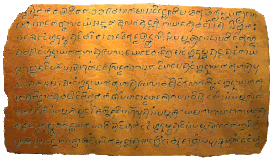| Alfabeto kawi | ||
|---|---|---|
 Cobre de Laguna, Luzón, c. 900 | ||
| Tipo | Alfasilabario bráhmico | |
| Idiomas | javanés antiguo, sánscrito, balinés, Old Malay y kawi | |
| Época | Siglo VIII - XVI | |
| Antecesores |
Brahmi
| |
| Hermanos | Grantha, tamil, jemer, mon, cham | |
| Dio lugar a | ||
| Dirección | dextroverso | |
| ISO 15924 |
Kawi, 368 | |
El alfabeto kawi (en indonesio: aksara kawi, del sánscrito : कवि "kavi" lit. "poeta"[1]), o también alfabeto javanés antiguo (en indonesio: aksara carakan kuna), es una escritura bráhmica encontrada principalmente en Java pero que utilizada en mucha partes de Insulindia entre el siglo VIII y el siglo XVI.[2] Es un abugida que significa que los caracteres se leen con una vocal inherente y que usa diacríticos para suprimir la vocal y representar una consonante pura, o para representar otras vocales diferentes.[3][4] Deriva del alfabeto pallava con influencia nagari.
- ↑ Preliminary Proposal to Encode the Kawi Script
- ↑ Perdana, A. B., & Nurwansah, I. (2020). L2/20-256 Preliminary Proposal to encode Kawi in the UCS.
- ↑ De Casparis, J. G. Indonesian Palaeography: A History of Writing in Indonesia from the beginnings to c. AD 1500, Leiden/Koln, 1975, pp. 35-42 with footnotes
- ↑ Briggs, Lawrence Palmer (1950). «The Origin of the Sailendra Dynasty: Present Status of the Question». Journal of the American Oriental Society (JSTOR) 70 (2): 78-82. ISSN 0003-0279. doi:10.2307/595536.